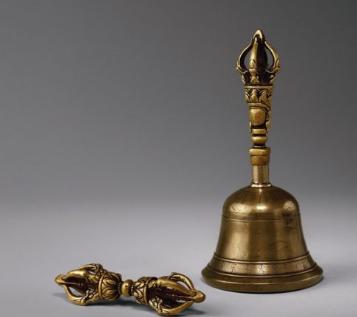How to use the Diamond Bell
602 views · Organized by 爱在西元 on 2022-02-09
When playing, hold the handle of the bell in the left hand and shake the bell mouth downward. It is used in Buddhist Dharma chanting and Buddhist music.
It is used in lama monasteries in Tibet, Qinghai, Gansu, Sichuan, Yunnan and Inner Mongolia, as well as in the distribution areas of Lamaism in Southeast Asian countries. When the monks are chanting sutras collectively, they are used by the leading lamas or living Buddhas.
In Tantric Buddhism, the vajra bell belongs to the father, representing convenience; the vajra bell belongs to the mother, representing wisdom. Convenience and wisdom are inseparable, so the bell and pestle must be a pair. Usually the right hand holds the pestle and the left hand holds the bell.
It is used in lama monasteries in Tibet, Qinghai, Gansu, Sichuan, Yunnan and Inner Mongolia, as well as in the distribution areas of Lamaism in Southeast Asian countries. When the monks are chanting sutras collectively, they are used by the leading lamas or living Buddhas.

In Tantric Buddhism, the vajra bell belongs to the father, representing convenience; the vajra bell belongs to the mother, representing wisdom. Convenience and wisdom are inseparable, so the bell and pestle must be a pair. Usually the right hand holds the pestle and the left hand holds the bell.
Involving musical instruments
The Jingang bell (pinyin: Jīngāng líng) is a musical instrument of the Tibetan, Mongolian, Naxi, Han and other ethnic groups. Tibetan called Zhibu, Ziba. The Han people call it Fa bell and Tibetan bell. With a long history, it was originally a Buddhist tantric instrument, which was introduced to my country from India. It is popular in Buddhist monasteries all over the country, especially in Tibet, Inner Mongolia, Qinghai, Gansu, Sichuan, Yunnan and other provinces. The body of the bell is shaped like a bell, with a round lower mouth. The top and body of the bell are decorated with intricate patterns. Inside the body of the bell is a copper clapper, which is used for lama chanting and Buddhist music. According to experts, the vajra bell is an instrument used in the practice of the Dharma.
Guess you like
Organized by 黑猫不是喵 on 2022-02-09
The diamond bell is composed of three parts: the bell body, the bell handle, and the bell tongue. The body of the bell is shaped like a bell, cast in bronze, with a round mouth, flush edges, and a delicate pattern on the top and around the body. The tongue of the bell is made of copper or iron, in the shape of a rod and hangs on the top of the inner cavity of the bell body.
read >>
 渝公网安备 50010702504639号
渝公网安备 50010702504639号